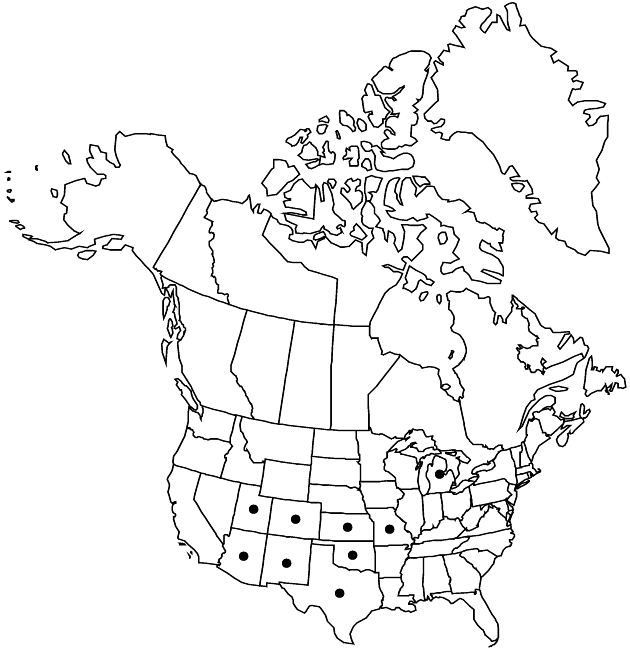Difference between revisions of "Artemisia carruthii"
Trans. Kansas Acad. Sci. 5: 51. 1877.
FNA>Volume Importer |
FNA>Volume Importer |
||
| Line 12: | Line 12: | ||
|name=Artemisia bakeri | |name=Artemisia bakeri | ||
|authority=Greene | |authority=Greene | ||
| − | }}{{Treatment/ID/Synonym | + | }} {{Treatment/ID/Synonym |
|name=Artemisia coloradensis | |name=Artemisia coloradensis | ||
|authority=Osterhout | |authority=Osterhout | ||
| − | }}{{Treatment/ID/Synonym | + | }} {{Treatment/ID/Synonym |
|name=Artemisia kansana | |name=Artemisia kansana | ||
|authority=Britton | |authority=Britton | ||
| − | }}{{Treatment/ID/Synonym | + | }} {{Treatment/ID/Synonym |
|name=Artemisia vulgaris subsp. wrightii | |name=Artemisia vulgaris subsp. wrightii | ||
|authority=(A. Gray) H. M. Hall & Clements | |authority=(A. Gray) H. M. Hall & Clements | ||
| − | }}{{Treatment/ID/Synonym | + | }} {{Treatment/ID/Synonym |
|name=Artemisia wrightii | |name=Artemisia wrightii | ||
|authority=A. Gray | |authority=A. Gray | ||
| Line 39: | Line 39: | ||
|elevation=600–2900 m | |elevation=600–2900 m | ||
|distribution=Ariz.;Colo.;Kans.;Mich.;Mo.;N.Mex.;Okla.;Tex.;Utah;Mexico (Chihuahua;Sonora). | |distribution=Ariz.;Colo.;Kans.;Mich.;Mo.;N.Mex.;Okla.;Tex.;Utah;Mexico (Chihuahua;Sonora). | ||
| − | |discussion=<p>Artemisia carruthii is closely related to members of the A. ludoviciana complex, with which it may intergrade.</p> | + | |discussion=<p><i>Artemisia carruthii</i> is closely related to members of the <i>A. ludoviciana</i> complex, with which it may intergrade.</p> |
|tables= | |tables= | ||
|references= | |references= | ||
| Line 63: | Line 63: | ||
|publication year=1877 | |publication year=1877 | ||
|special status= | |special status= | ||
| − | |source xml=https://jpend@bitbucket.org/aafc-mbb/fna-data-curation.git/src/ | + | |source xml=https://jpend@bitbucket.org/aafc-mbb/fna-data-curation.git/src/8f726806613d60c220dc4493de13607dd3150896/coarse_grained_fna_xml/V19-20-21/V19_896.xml |
|tribe=Asteraceae tribe Anthemideae | |tribe=Asteraceae tribe Anthemideae | ||
|genus=Artemisia | |genus=Artemisia | ||
Revision as of 15:15, 18 September 2019
Perennials, 15–40(–70) cm, faintly aromatic (rhizomatous). Stems mostly 3–8, ascending, brown to gray-green, simple (bases curved, somewhat woody), sparsely to densely tomentose. Leaves cauline, bicolor (± gray-green); blades narrowly elliptic, 0.1–2.5(–3) × 0.5–1 cm (gradually smaller distally), relatively deeply pinnatifid (lobes 3–5), faces densely tomentose (abaxial) to sparsely hairy (adaxial). Heads (usually nodding) in (leafy) paniculiform arrays 10–30 × 3–9 cm (branches erect). Involucres campanulate, 2–2.5(–3) × 1.5–3 mm. Phyllaries lanceolate, gray-tomentose. Florets: pistillate 1–5; bisexual 7–25; corollas pale yellow, 1–2 mm, glandular-pubescent. Cypselae (light brown) cylindro-elliptic, ca. 0.5 mm, (curved at summits, scarcely nerved), glabrous (shining). 2n = 18.
Phenology: Flowering mid summer–early fall.
Habitat: Open sites, usually sandy soils, wooded areas, grasslands, railroads
Elevation: 600–2900 m
Distribution

Ariz., Colo., Kans., Mich., Mo., N.Mex., Okla., Tex., Utah, Mexico (Chihuahua, Sonora).
Discussion
Artemisia carruthii is closely related to members of the A. ludoviciana complex, with which it may intergrade.
Selected References
None.